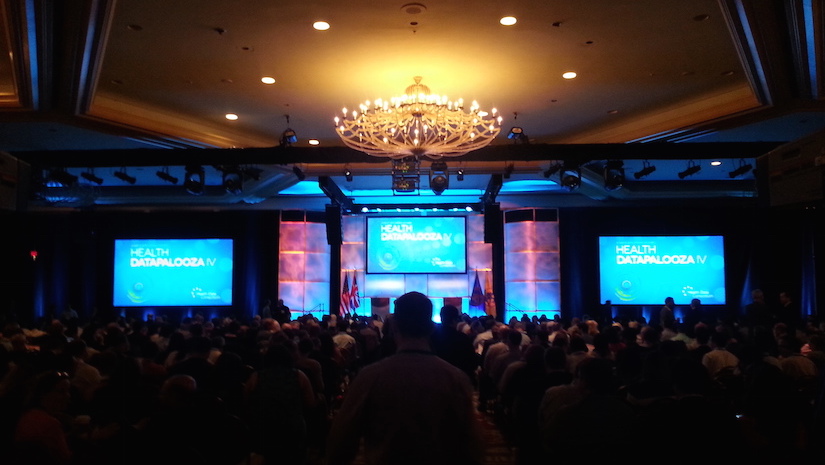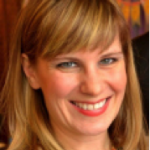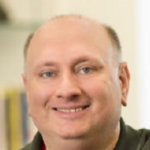The following post is a collaborative effort between Nina Grigoriev, Sara Holoubek, Julia Wu and Jerry Matczak. After running into each other at this year’s Health Datapalooza, we wanted to share our experience with making unexpected connections.
Health Datapalooza, now in its fifth year, is hosted by the Health Data Consortium (HDC). The HDC’s mission is to “cultivate the new thinking, innovative practices, and the system-wide reform needed to help tackle the enormous and complex challenge of harnessing health data.”
A couple of weeks ago, we had the opportunity to attend Health Datapolooza in Washington, D.C. It’s one of the most inspiring and diverse gatherings of the year, fostering what U.S. Department of Health and Human Services CTO Bryan Sivak and White House CTO Todd Park have called “serendiptious collisions.”
This year, the four of us were thrilled to have our own serendipitous collision, which proved the real value of attending the conference. Allow us to introduce ourselves, and explain how these collisions came about…
Nina
I’m Nina Grigoriev, and I work in digital communications for the Guttmacher Institute, a global nonprofit focusing on reproductive health research and policy analysis.
I attended Datapalooza this year, because, at Guttmacher we strive to use data visualization more effectively to disseminate our work and promote policy change. As a ‘Palooza newbie I was blown away by the wealth of knowledge and experience, and the candid sharing of both successes and challenges in visualizing health data. Thousands of academics, reporters, advocates and policymakers turn to Guttmacher each day for reproductive health data, so we’re thinking deeply about how to make that information easier to find share, and present visually. Where else but Health Datapalooza can you hear Kathleen Sebelius keynote in the morning, go off to a session where the CDC presents alongside Tableau, get the inside scoop on ProPublica’s use of public data?
I took the opportunity to finally find out who was behind those moving “Walking Gallery” jackets over a serendipitous coffee break one morning. I noticed a man in line wearing one of the jackets and approached him asking if he could talk to me about the meaning behind the jackets. As we were talking, another woman stopped by to say hello to Jerry. I soon learned that her name was Sara and she worked for Luminary Labs…
Sara
I’m Sara Holoubek and I’m the CEO and founder of Luminary Labs, a consultancy focused on operationalizing innovation. My firm develops strategies and innovation systems for Fortune 500 and government leaders seeking to transform their organizations and industries.
This was my fourth Health Datapalooza, and it did not disappoint. As Luminary Labs produces the Health Data Challenge Series in partnership with the Health Data Consortium, we curated three conversations in a dedicated room for all things challenges at the event. And I also took my very first open data selfie, with Dr. Taha Kass Hout, himself!
As I approached the coffee line, I recognized Jerry from a conversation we’d had a couple of years ago. I didn’t want to miss an opportunity to say hello, so I apologized for interrupting, greeted Jerry and introduced myself to Nina. As Nina and I began chatting about her company we realized that we both knew Julia Wu, who works with me at Luminary Labs…
Julia
I’m Julia Wu and I work as a Communications Strategist at Luminary Labs, where I focus on storytelling and marketing for our client’s innovation projects.
This was my first Health Datapalooza, and I came to help represent Health Data Challenges (our partnership with the HDC) and to fully immerse myself in the health data mayhem. I spent much of the conference chatting with healthcare leaders and startups about open innovation, attending the fabulous keynotes, and catching up on the big announcements.
Even though I wasn’t present for the serendipitous collision, I was thrilled to learn that Nina and Sara had made a connection!
Jerry
I’m Jerry Matczak, Community Manager at Lilly COI and responsible for the Lilly COI blog and Twitter account, and for Lilly COI connecting our efforts to leverage open data methods to better engage patients in clinical research. This was my third Health Datapalooza, and the people and conversations from Datapalooza help shape our ongoing strategy and projects. We provide open APIs to information about clinical trials, and we hope to foster a marketplace where patients, researchers and other stakeholders build tools to help bring clinical trials to people who need them.
I’m tickled by these types of serendipitous meetings, and believe they are foundational to stimulate collaboration and innovation. There’s nothing better than connecting with others around common goals, like creating value from open healthcare data and technology to improve people’s lives.
What We Took Away
In a matter of about four minutes, personal connections were made among the four of us that we remember, value and carry forward. We each now have a greater understanding of each other’s interests, passions and areas of expertise. We each left with positive, personal feelings about each other and our work, and have expanded our networks to include more people we can tap for help with new ideas and projects and are likely to talk again. This little microcosm of serendipitous collisions is a good example of the value of the conference, and the value of openly sharing as much as possible with your peers and colleagues.
The Network Effect & The Power of Weak Ties
In some cases, the value of a product or service is dependent upon the number of people using it. (This is often referred to as the network effect.) This principle applies well to health data. More and more organizations and companies are making health data available to the public. But, without a large and diverse network of people with the ability to put it to use, the data has little value. Health Datapalooza provides the perfect setting to apply the network affect to health data, combined with the value of “weak tie” relationships:
Weak social ties, it is argued, are responsible for the majority of the embeddedness and structure of social networks in society as well as the transmission of information through these networks. (Wikipedia)
People from all facets of the health data industry—government agencies, technology firms, academic institutions, corporations, start-ups, healthcare delivery specialists, and patients—come to the conference to share their ideas, their latest products and their hopes for the future of healthcare. Even though they come with different experiences, different insights and different skill sets, they all have the same goal in mind: improve the healthcare experience for patients.
The best part, however, is that the conference provided the opportunities for new ideas—and the people who own them—to bump into one another and form connections that help one another access new resources and data sets they may not have even realized they needed, and to expand and build upon their original ideas. This is how true innovation gets its start.
Overall what made Health Datapalooza such an important conference is that it allowed us to connect with people who could help us see and understand new resources in ways we may not have thought of before, and to build up a larger network of people who can provide us with the skills and insights needed to make a real difference in the health ecosystem.







